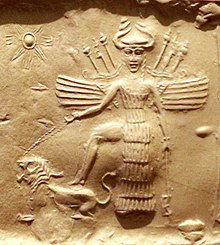Inanna
| Inanna/Ishtar | |
|---|---|
| |
 Goddess Ishtar on an Akkadian Empire seal, 2350–2150 BC. She is equipped with weapons on her back, has a horned helmet, and is trampling a lion held on a leash. | |
| Major cult center | Uruk; Agade; Nineveh |
| Abode | Heaven |
| Planet | Venus |
| Symbol | hook-shaped knot of reeds, eight-pointed star, lion, rosette, dove |
| Mount | Lion |
| Personal information | |
| Parents | |
| Siblings |
|
| Consort | Dumuzid the Shepherd; Zababa; many unnamed others |
| Children | usually none, but rarely Lulal and/or Shara or Nanaya |
| Equivalents | |
| Greek equivalent | Aphrodite, Athena[5] |
| Roman equivalent | Venus, Minerva[5] |
| Canaanite equivalent | Astarte |
| Elamite equivalent | Pinikir |
| Hurrian equivalent | Shaushka |
Inanna[a] is an ancient Mesopotamian goddess associated with love, beauty, sex, war, justice and political power. She was originally worshiped in Sumer under the name "Inanna", and was later worshipped by the Akkadians, Babylonians, and Assyrians under the name Ishtar.[b] She was known as the "Queen of Heaven" and was the patron goddess of the Eanna temple at the city of Uruk, which was her main cult center. She was associated with the planet Venus and her most prominent symbols included the lion and the eight-pointed star. Her husband was the god Dumuzid (later known as Tammuz) and her sukkal, or personal attendant, was the goddess Ninshubur (who later became conflated with the male deities Ilabrat and Papsukkal).
Inanna was worshiped in Sumer at least as early as the Uruk period (c. 4000 BC – c. 3100 BC), but she had little cult activity before the conquest of Sargon of Akkad. During the post-Sargonic era, she became one of the most widely venerated deities in the Sumerian pantheon,[8][9] with temples across Mesopotamia. The cult of Inanna/Ishtar, which may have been associated with a variety of sexual rites, was continued by the East Semitic-speaking people (Akkadians, Assyrians and Babylonians) who succeeded and absorbed the Sumerians in the region. She was especially beloved by the Assyrians, who elevated her to become the highest deity in their pantheon, ranking above their own national god Ashur. Inanna/Ishtar is alluded to in the Hebrew Bible and she greatly influenced the Ugaritic Ashtart and later Phoenician Astarte, who in turn possibly influenced the development of the Greek goddess Aphrodite. Her cult continued to flourish until its gradual decline between the first and sixth centuries AD in the wake of Christianity.
Inanna appears in more myths than any other Sumerian deity.[10][11][12] She also had a uniquely high number of epithets and alternate names, comparable only to Nergal.[13] Many of her myths involve her taking over the domains of other deities. She was believed to have stolen the mes, which represented all positive and negative aspects of civilization, from Enki, the god of wisdom. She was also believed to have taken over the Eanna temple from An, the god of the sky. Alongside her twin brother Utu (later known as Shamash), Inanna was the enforcer of divine justice; she destroyed Mount Ebih for having challenged her authority, unleashed her fury upon the gardener Shukaletuda after he raped her in her sleep, and tracked down the bandit woman Bilulu and killed her in divine retribution for having murdered Dumuzid. In the standard Akkadian version of the Epic of Gilgamesh, Ishtar asks Gilgamesh to become her consort. When he refuses, she unleashes the Bull of Heaven, resulting in the death of Enkidu and Gilgamesh's subsequent grapple with his mortality.
Inanna/Ishtar's most famous myth is the story of her descent into and return from Kur, the Ancient Mesopotamian underworld, a myth in which she attempts to conquer the domain of her older sister Ereshkigal, the queen of the underworld, but is instead deemed guilty by the seven judges of the underworld and struck dead. Three days later, Ninshubur pleads with all the gods to bring Inanna back, but all of them refuse her except Enki, who sends two sexless beings to rescue Inanna. They escort Inanna out of the underworld, but the galla, the guardians of the underworld, drag her husband Dumuzid down to the Underworld as her replacement. Dumuzid is eventually permitted to return to heaven for half the year while his sister Geshtinanna remains in the underworld for the other half, resulting in the cycle of the seasons.
Etymology[]

Inanna and Ishtar were originally separate, unrelated deities,[14][3][15][16] but they were equated with each other during the reign of Sargon of Akkad and came to be regarded as effectively the same goddess under two different names.[14][3][15][16] Inanna's name may derive from the Sumerian phrase nin-an-ak, meaning "Lady of Heaven",[17][18] but the cuneiform sign for Inanna (